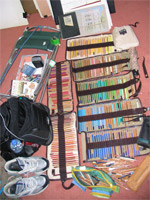Art Materials for Artists
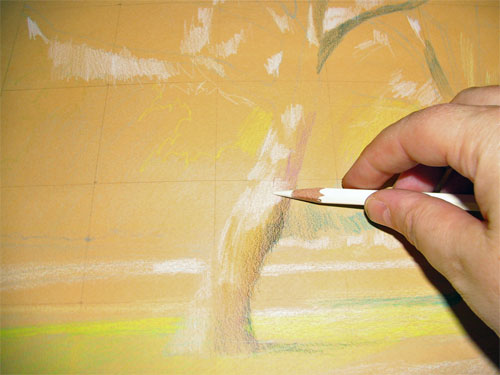 | A SUMMARY OF INFORMATION ABOUT MY ART MATERIALS | 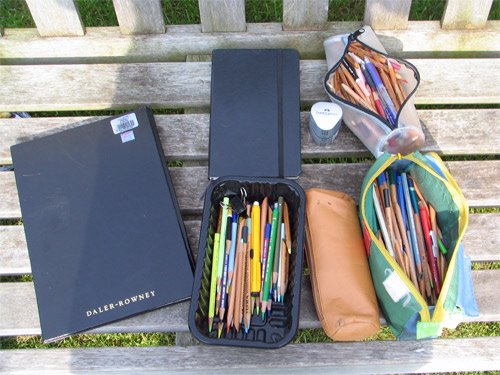 |
I've learned about art materials in the past from many different artists whose recommendations I valued. My philosophy is that it is good to share and we all have something to learn. You may learn something new from me. | ||
Scroll down - and on this page you will find: Details of the art materials and equipment that work for me and which I use - both at home and while travelling. click on a heading to be taken direct to that section | ||
Media
| Equipment | Suppliers |
provide wider perspectives on different media, art supplies and equipment, subject matter, techniques, and the art business | ||
Learning about art materials | |||
Advice about art materialsThis is the approach I follow and essentially represents my advice to others.
|
 | My Art Supplies - art materials & suppliers I use | ||
Media and associated tools | Supports (Paper / Board) | ||
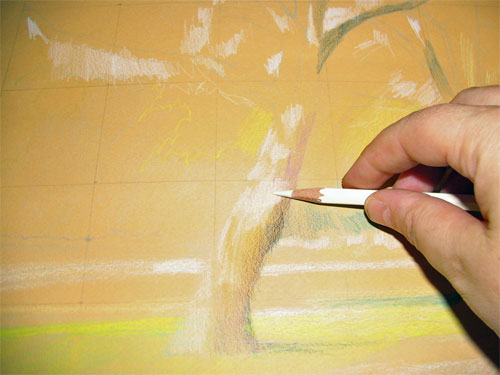 | Original artwork for sale is completed using light fast and archival quality artist materials. Whether I'm using pastels or coloured pencils, my approach tends to be the same | The look of a piece can depend on the type of support. Work completed on smoother surfaces tends to be coloured pencil only and less 'sketchy' than work completed on more abrasive surfaces. | |
Pastels | My 'workhorse' pastels are now Unison pastels - made in the UK. Other brands of soft pastel that have been well used in the past (see left) include
| I always use an abrasive support which include:
| |
See my site  Pastels - Resources for Artists and Pastels - Resources for Artists and  Pastel Paper and Pastel Boards for more about the different brands and their different characteristics and qualities of both pastels and different types of support Pastel Paper and Pastel Boards for more about the different brands and their different characteristics and qualities of both pastels and different types of support | |||
| I have a variety of ways to carry pastels when travelling or working plein air | These are links to
| ||
Coloured Pencils | Various brands of coloured pencils are used, including
You can see my pencils laid out here in their Derwent Pencil Wraps (see below) | Coloured pencil paintings are completed on a variety of media:
| |
See my site  Coloured Pencils - Resources for Artists for more about different brands and their different characteristics and qualities including information about lightfastness Coloured Pencils - Resources for Artists for more about different brands and their different characteristics and qualities including information about lightfastness | |||
See my site  Paper and Support - Resources for Artists for more about the different kinds of support I use Paper and Support - Resources for Artists for more about the different kinds of support I use | |||
| I carry my coloured pencils around in a variety of ways and spend a lot of time staring at pencil cases to see if I can find the perfect one! | These are links to:
| ||
| I use Talens Van Gogh Watercolour Pencils | ||
| top | 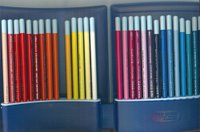 | 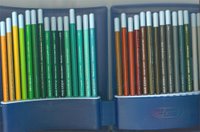 | |
| I have a small Pentelbrush with an in-built water reservoir for use with watercolour pencils |
| ||
Art Boardstop | 5mm Foam Core provides an excellent lightweight support when travelling. I usually have a piece cut to the size of the bottom of my suitcase. As a rigid support it means I don't need a heavy portfolio to protect paper while travelling. | ||
Sketchbookstop | In my sketchbooks I use:
See how I use them  here. here. Read more about them  here. here. | ||
See  Travels with a Sketchbook - Resources for Artists for more about the use of sketchbooks by travellers and artists in the past and the present day. Travels with a Sketchbook - Resources for Artists for more about the use of sketchbooks by travellers and artists in the past and the present day.See  The Best Books about Drawing and Sketching for useful guides: The Best Books about Drawing and Sketching for useful guides:
| |||
top | For nearly 20 years I've used black hardback Daler Rowney sketchbooks and have them in different sizes. My favourite is the large A4 size which is excellent for large sketches. It contains a pale creamy white bond type paper. Each page is perforated near the binding making it very easy to either remove pages or to fold a page to enable easy sketching across a double page spread (making an image of approx. 11" x 18"). This paper is absolutely brilliant for use with coloured pencils. Warning: The paper really does not like water at all. Using even a limited amount of water with watercolour pencils generated wrinkles. Take a look at the effect on my sketch of  Sydney Opera House when I used water on the reverse! Sydney Opera House when I used water on the reverse! | ||
Moleskine sketchbookstop | 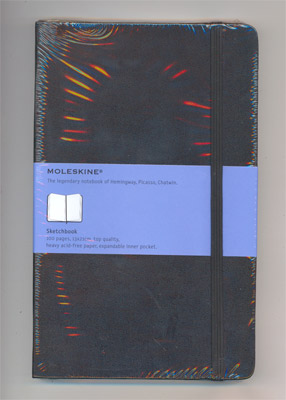 I started using a Moleskine sketchbook at the end of 2005 and find them very easy to carry around. There are three sizes - a small, medium (A5ish) and large (A4) and very large (A3). I have all of them but prefer to use the medium and large version. The main advantages for me are: I started using a Moleskine sketchbook at the end of 2005 and find them very easy to carry around. There are three sizes - a small, medium (A5ish) and large (A4) and very large (A3). I have all of them but prefer to use the medium and large version. The main advantages for me are:
| ||
Pen and Inktop | I mainly use three different pens (see below) for pen and ink drawings. Pen and ink work is executed
| ||
See  Pen and Ink - Resources for Artists for information and advice from various websites for artists using pen and ink. Topics covered include information about pen and ink brands and associated products and tips and techniques for working with pen and ink. Pen and Ink - Resources for Artists for information and advice from various websites for artists using pen and ink. Topics covered include information about pen and ink brands and associated products and tips and techniques for working with pen and ink. | |||
You can read more about this wonderful pen  here. It's difficult to find and I buy masses of them every time I come across them. See Cult Pens below if you want to order a supply. here. It's difficult to find and I buy masses of them every time I come across them. See Cult Pens below if you want to order a supply. | |||
| Early pen and ink drawings were done using a Rotring Art Pen with an EF (extra fine) nib with Rotring Drawing Inks(black and sepia). It's a very nicely balanced pen which uses ink cartridges (various colours) but it can be converted. There is a choice of five calligraphy nibs as well as fine and extra fine sketching nibs. I often turn mine over and use the nib the wrong way up to get very fine lines. Read more about it in my very popular blog post  Rotring Art Pen. I understand that these pens may not be produced anymore. My blog post represents my attempt to create demand for a pen which is much loved pen by me and other artists. The post contains links to suppliers and more technical details Rotring Art Pen. I understand that these pens may not be produced anymore. My blog post represents my attempt to create demand for a pen which is much loved pen by me and other artists. The post contains links to suppliers and more technical details | |||
 e-1800 Profipen. This is a high-tech fibrepen with metal-framed round tip. It comes in 4 stroke widths and uses water-resistant, lightfast pigment ink, colours 001-004. This one you can use with watercolour e-1800 Profipen. This is a high-tech fibrepen with metal-framed round tip. It comes in 4 stroke widths and uses water-resistant, lightfast pigment ink, colours 001-004. This one you can use with watercolour | |||
Graphite and Pencil | I use a mix of:
| 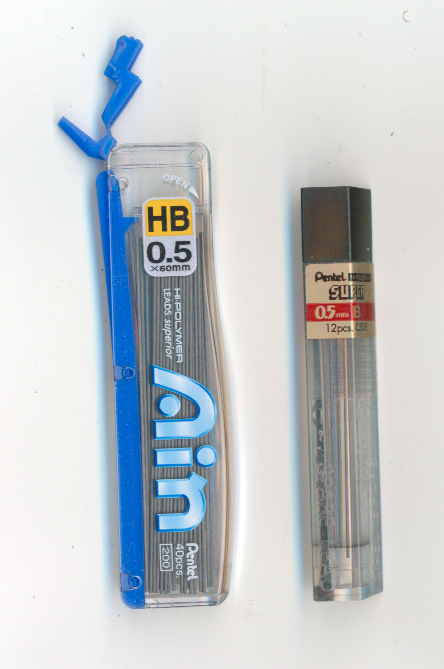 | |
Battery powered top | 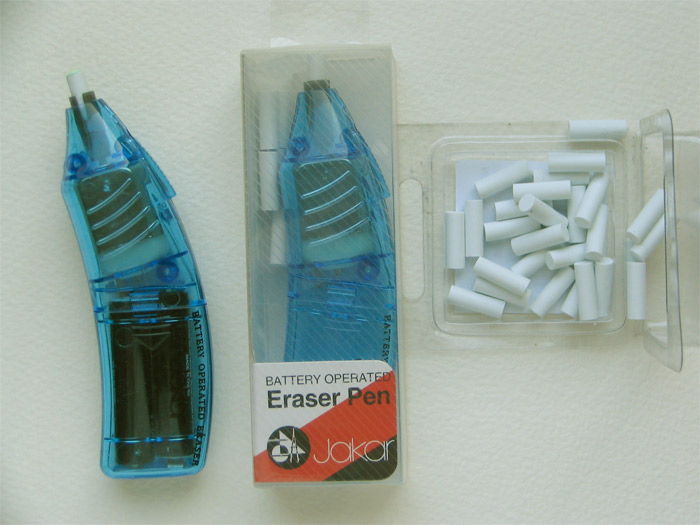 I absolutely LOVE my Jakar battery powered eraser pen. Read more about this particular eraser in I absolutely LOVE my Jakar battery powered eraser pen. Read more about this particular eraser in  this post on my blog 'Making a Mark'. Also read about my technique for drawing using this eraser and see pictures developed as a result this post on my blog 'Making a Mark'. Also read about my technique for drawing using this eraser and see pictures developed as a result  here and here and  here. here. Find more more information about erasers on  Art Equipment - Resources for Artists - erasers Art Equipment - Resources for Artists - erasers | ||
Tuff Stuff eraser top | 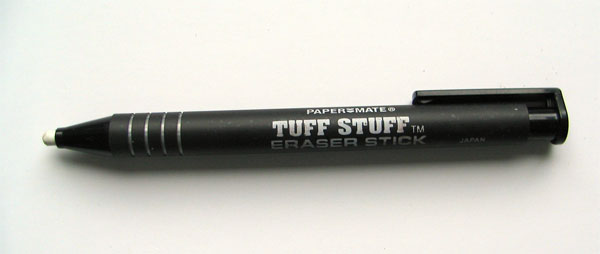 Recommended to me by Recommended to me by  Diana Ponting, thisTuff Stuff Eraser stick by Paper Mate is absolutely perfect for erasing pastel on an abrasive surface. It gets right back to the original surface. Diana Ponting, thisTuff Stuff Eraser stick by Paper Mate is absolutely perfect for erasing pastel on an abrasive surface. It gets right back to the original surface. | ||
Blu-Tak - for erasingtop | 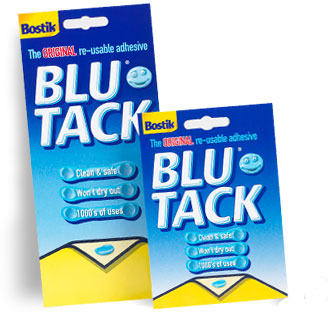 Blu Tack is very effective at removing coloured pencil marks from paper. It is a reusable adhesive which can be molded to different shapes - such as cylinder shapes (for rolling) or 'spikes' for dabbing at very small areas. This is not a material suitable for fast and easy erasure of large areas but works well at removing marks from smaller areas. Blu Tack is very effective at removing coloured pencil marks from paper. It is a reusable adhesive which can be molded to different shapes - such as cylinder shapes (for rolling) or 'spikes' for dabbing at very small areas. This is not a material suitable for fast and easy erasure of large areas but works well at removing marks from smaller areas.Blu Tack is readily available in the UK (but not in the USA). | ||
Pencil sharpenerstop | 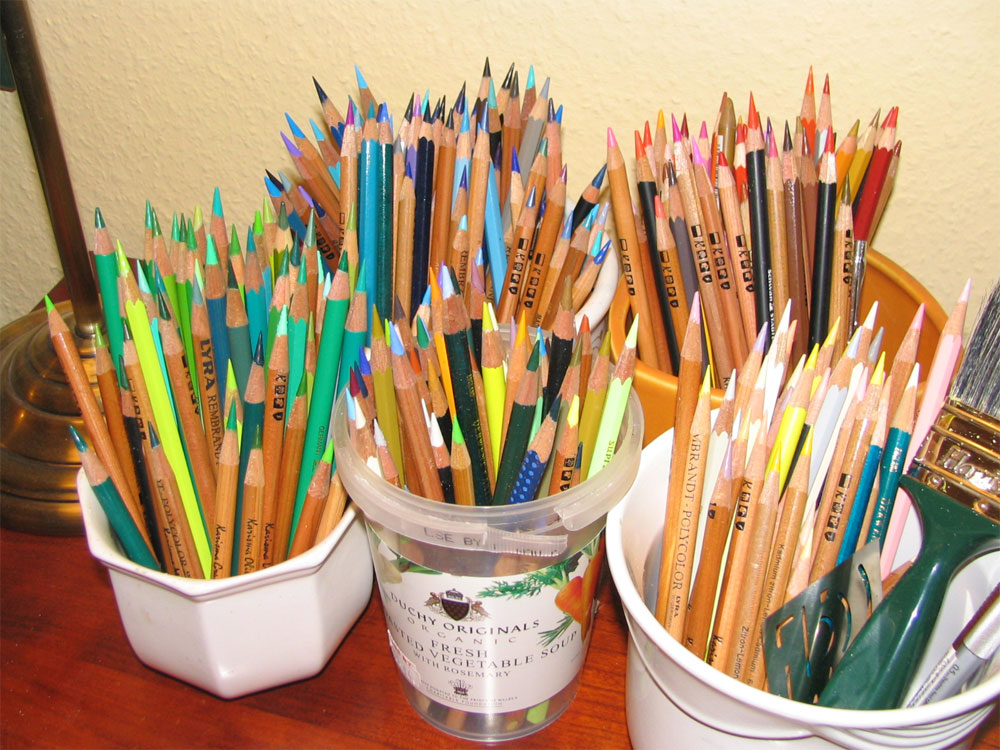 I use hand operated, battery powered and electric pencil sharpeners (see below for more details). I use hand operated, battery powered and electric pencil sharpeners (see below for more details). I recommend using battery or electric sharpeners for anybody who has arthritis or who suffers from tenosynovitis in their hand/arm as I do. You too can have pencils with needle sharp points like this! | ||
Hand held sharpeners | 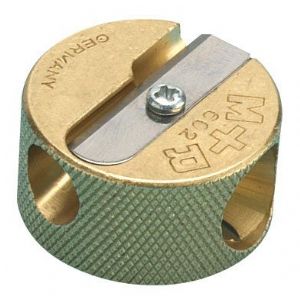 This is my favourite handheld sharpener and is great for sketching. It is made of brass, is well designed, easy to hold and its weight means that it doesn't get lost easily. It has two holes for different sized pencils (hence it can sharpen the Derwent Pencils) Replaceable blades mean that it can be used over the long term. The compact size also means it fits easily into pencil cases. Speaking personally, I carry this very effective sharpener around with me all the time in my purse. This is my favourite handheld sharpener and is great for sketching. It is made of brass, is well designed, easy to hold and its weight means that it doesn't get lost easily. It has two holes for different sized pencils (hence it can sharpen the Derwent Pencils) Replaceable blades mean that it can be used over the long term. The compact size also means it fits easily into pencil cases. Speaking personally, I carry this very effective sharpener around with me all the time in my purse. Read my  Product Review - Round Solid Brass Double-Hole Pencil Sharpener Product Review - Round Solid Brass Double-Hole Pencil Sharpener | ||
This is an excellent manual pencil sharpener for those who like their pencil leads to have a long point. I recommend it for occasional use eg when sketching. It's made by KUM - a manufacturer with lot of experience in the manufacture of manual pencil sharpeners. Read my  Product Review: KUM Automatic Long Point Pencil Sharpener Product Review: KUM Automatic Long Point Pencil Sharpener | 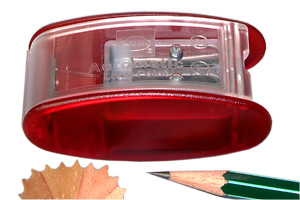 | ||
top | The advantage of this Prismcolor sharpener is that it contains all the shavings and is designed for coloured pencils. I prefer my Faber Castell 'Grip' hand sharpenerwhich also has a slot for colour pencils! | 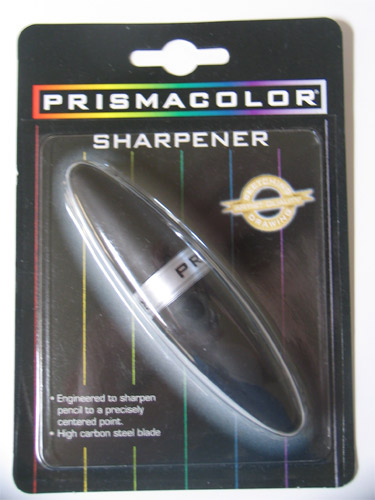 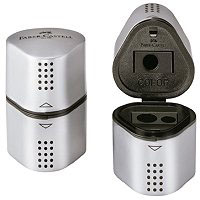 | |
Electric pencil sharpenertop | 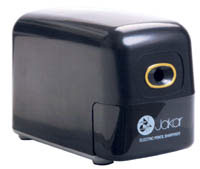 My Jakar 5151 mains powered electric pencil sharpener is my heavy duty / use all the time indoors sharpener. It's suitable for graphite and good qualitycoloured pencils up to 8mm thick. It has a couple of safety features. My Jakar 5151 mains powered electric pencil sharpener is my heavy duty / use all the time indoors sharpener. It's suitable for graphite and good qualitycoloured pencils up to 8mm thick. It has a couple of safety features.
Read more about it in my  Product review: Jakar Electric Pencil Sharpener Product review: Jakar Electric Pencil Sharpener | ||
topBattery powered pencil sharpener | 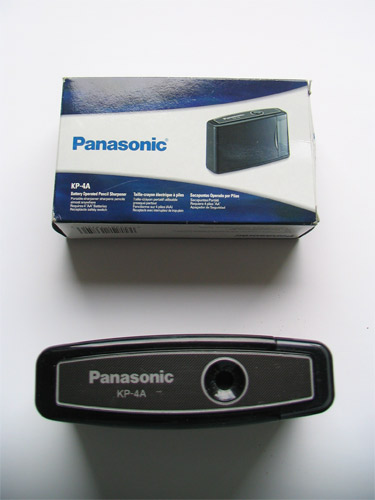 My Panasonic KP - 4A battery powered sharpener is amazing. It has My Panasonic KP - 4A battery powered sharpener is amazing. It has
PLEASE BRING BACK THIS SHARPENER! | ||
Drafting Brushtop |  The waste products of erasure and sharpening coloured pencils need to be removed to avoid spoiling a paper. The waste products of erasure and sharpening coloured pencils need to be removed to avoid spoiling a paper. I use a Drafting Brush (sometimes called a Drafting Broom) to clean paper when using coloured pencils. A 2" paint brush of decent quality is a good substitute (and is easier to keep me in my tubs of pencils). Wiping a freshly sharpened pencil through a brush after sharpening removes all small shavings. | ||
Drawing Aidstop | There are various aids which can make drawing 'en plein air' or otherwise a little bit easier | ||
Derwent Pencil Wrap | I have a number of  Derwent Pencil Wraps which are invaluable when travelling - you can see them in the picture near the top. The wraps are made from tough canvas and have leather look trim and a secure closure. This means it lies flat when in use and rolls up for travelling (and is also very light). Inside it has individual compartments to hold and protect up to 30 standard-size pencils. Derwent Pencil Wraps which are invaluable when travelling - you can see them in the picture near the top. The wraps are made from tough canvas and have leather look trim and a secure closure. This means it lies flat when in use and rolls up for travelling (and is also very light). Inside it has individual compartments to hold and protect up to 30 standard-size pencils. | ||
Value scales | This grey scale and value fiinder by the  Color Wheel Company is excellent for being to surround an area to check out what sort of value it is and then whether I've managed to achieve the right values. See Color Wheel Company is excellent for being to surround an area to check out what sort of value it is and then whether I've managed to achieve the right values. See  How to identify and assess value and tone quickly How to identify and assess value and tone quickly |  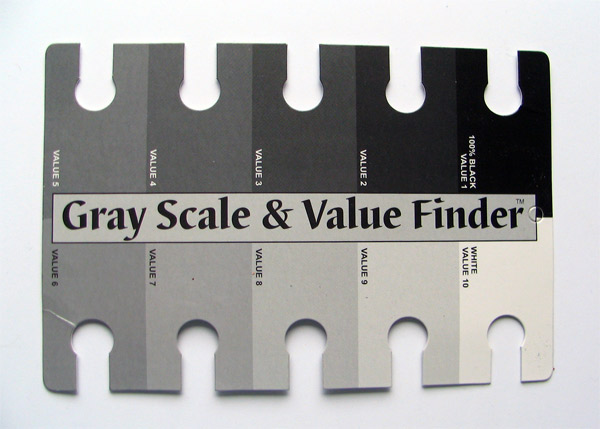 | |
Val-U-Viewer | 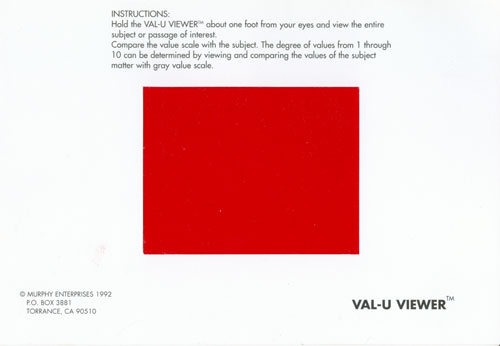 As recommended to me by As recommended to me by  Sally Strand. Sally Strand. This provides a very good basis for both identifying a crop of an image and assessing the correct strength of the values that can be seen. Read more about it in my blog post  here. This contains a link to the website of the chap who makes them. here. This contains a link to the website of the chap who makes them. | ||
Viewfinder - rule of thirds | 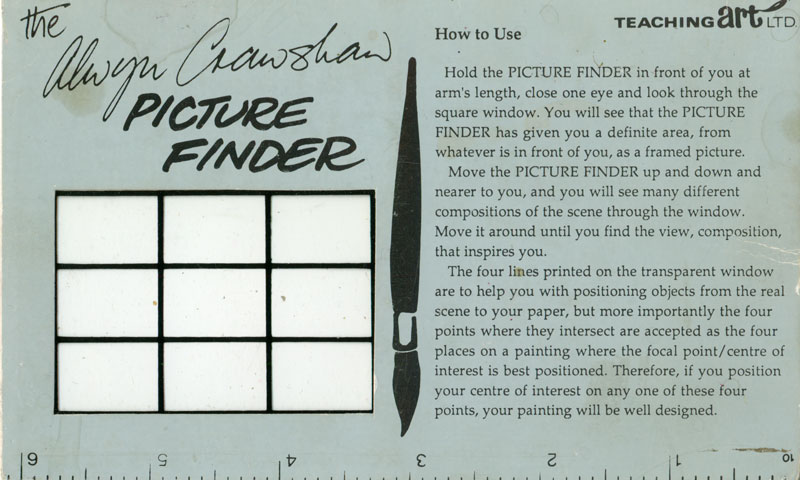 The viewfinder includes a clear plastic window (which doesn't scratch) which is 2.5 inches wide and 1.75 inches high (which gives is a 10:8 ratio). It's also clearly marked with lines for the 'rule of thirds' to help with compositions and finding the 'sweet spots'. It's possible to create and print one out using good quality perspex. | ||
Viewfinder - for scale | Some people measure with their pencils - and while that's great for simple scenes, I find this viewfinder with a grid very helpful for any scenes which might have a a complicated structure - particularly buildings. It helps me to check which lines are really vertical and which ones have got a distinct lean. | 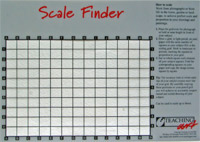 | |
Sketching Chair |  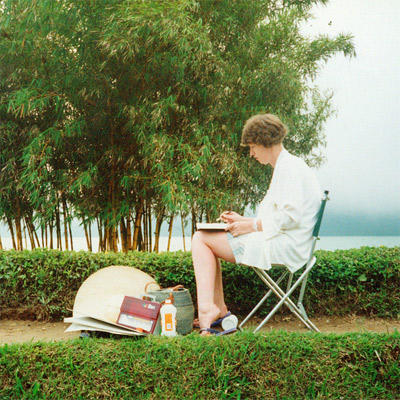 My Phillips Folding Chair has a lightweight metal frame and strong canvas seat and back. The folding mechanism is very easy to work. It is excellent for travelling. I've had two travelling around the UK and the world sketching and painting in the last 20 years or so. I only had to get the second as the first went AWOL after it was left behind on a luggage trolley by mistake at the end of a 26 hour flight! My Phillips Folding Chair has a lightweight metal frame and strong canvas seat and back. The folding mechanism is very easy to work. It is excellent for travelling. I've had two travelling around the UK and the world sketching and painting in the last 20 years or so. I only had to get the second as the first went AWOL after it was left behind on a luggage trolley by mistake at the end of a 26 hour flight! Warning!
| ||
See  Art Equipment - Resources for Artists for more details about various items of equipment. Art Equipment - Resources for Artists for more details about various items of equipment. | |||
Links to suppliers - UK |
|
| |
- supply Pilot G-TEC-C4 drawing pens and a wide range of other pens and pencils for drawing as well as writing. A very helpful company who know even more than you can read about on their very helpful ebsite | |||
| Links to suppliers - USA |
, San Clemente, California. |
in San Diego, California | |
Links to the rest of the website |  Home Home About the Artist About the Artist |  Back to the top of the page Back to the top of the page | |
| Last updated: 6 June 2017 | |||
Visitors counter cannot be automatically migrated

